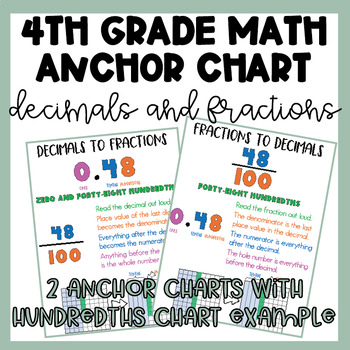Decimals to Fractions | Anchor Chart | Area Model | Written Word Form
What educators are saying
Also included in
- Introducing our comprehensive Fourth Grade Math Mega Bundle – your one-stop solution for mastering all the fourth-grade math standards! This bundle combines all the digital step-by-step instruction products from our collection, offering a treasure trove of resources to support your students' math lePrice $63.00Original Price $71.50Save $8.50
- Enhance your math instruction with our comprehensive Fraction Anchor Chart BUNDLE! This bundle includes detailed anchor charts for teaching and reinforcing essential fraction concepts such as adding, multiplying, comparing, and converting fractions. Perfect for visual learners, these anchor charts pPrice $14.50Original Price $21.00Save $6.50
Description
Make teaching decimals and fractions easier with our comprehensive Decimals to Fractions Anchor Chart. This resource is designed to help students understand the relationship between decimals and fractions using area models and written word form. Perfect for visual learners, this anchor chart provides clear, step-by-step instructions to support your math curriculum.
What's Included:
- Anchor Chart for Decimals to Fractions: Detailed steps for converting decimals to fractions with denominators of 10 and 100.
- Area Model Illustrations: Visual representations to help students understand the conversion process.
- Written Word Form: Clear examples of how to write decimals and fractions in word form.
- Color-Coded Steps: Helps students easily follow and understand each step of the conversion process.
Key Features:
- Visual Learning Aid: Enhances student understanding through clear and concise visual representations.
- Step-by-Step Instructions: Breaks down the conversion process into manageable steps.
- Aligned with Common Core Standards: Supports standards for understanding fractions and decimals.
- Versatile Use: Ideal for classroom displays, student reference sheets, and interactive notebooks.
Perfect For:
- Elementary and Middle School Teachers: Simplify the teaching of decimals and fractions.
- Math Intervention: Provide extra support for students who need it.
- Homeschooling: Use as a visual aid to enhance math lessons at home.
- Tutoring: A valuable resource for math tutors working with students on foundational skills.
Why You'll Love It: Our Decimals to Fractions Anchor Chart makes it easy to teach and understand the relationship between decimals and fractions. The clear visuals and step-by-step instructions help students grasp these essential math concepts, making your lessons more effective and engaging.
Check out other fraction products:
Comparing Fractions with Unlike Denominators
Tags: Decimals to Fractions, Anchor Chart, Area Model, Written Word Form, Math Strategies, Common Core Math, Visual Learning, Elementary Math, Middle School Math, Math Intervention, Printable Math Resources.





